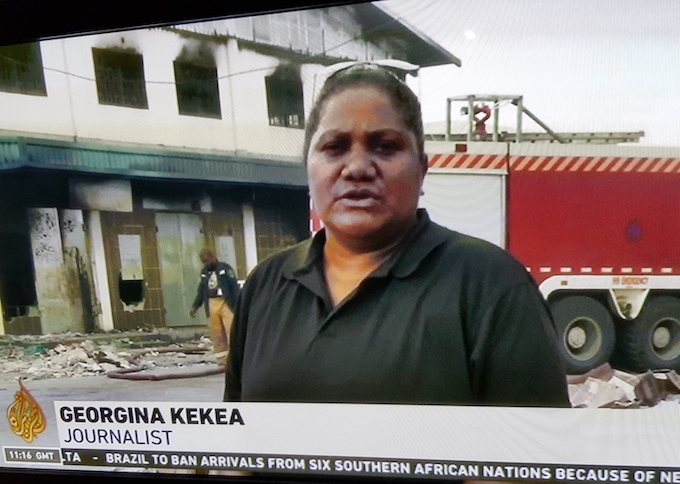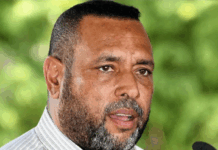
By Mike Tua in Honiara
Facing angry rioters threatening them with physical attacks, Solomon Islands mainstream and freelance journalists and photographers were confronted with an unsettling reality during last week’s three days of rioting in Honiara.
Local journalists in the country equipped with their cameras and limited protection were working solo on assignments for their newsrooms when the riots happened.
A freelance and multimedia woman journalist, Georgina Kekea tells of the threats to attack her and her news crew by the crowd as they marched down to Vavaya Ridge road, next to City Motel in Central Honiara.
- READ MORE: Backgrounder: Solomon Islands riots push nation into slippery slide of self-implosion
- Other reports on the Solomon Islands crisis
“They threatened to shoot us with stones and swore obscenities at us. They shouted, ‘Go away with your cameras!’
“Those that knew me personally didn’t say anything. Those that did, I assume they knew of me but do not know me personally; some might not know me at all,” says Kekea, who is president of the Media Association of Solomon Islands (MASI).
“I don’t think any call for respect for journalists at this point would make a difference,” she told Sunday Isles.
“Except that I am surprised that people who spoke highly of culture do not have any respect at all for culture.
‘Women doing our job’
“We are women doing our job just like any other, and if that’s the way Solomon Islands men treat women in general, I am sorry for our country.
“We are lost. Nothing will and can change unless we the people change ourselves. We will not make a difference.”
Kekea pleads for people to simply allow the media to do their job.

“MASI condemned the recent riots that happened and called on the authorities too to respect the work of the media,” she said.
In a media statement from the Pacific Freedom Forum (PFF), chair Bernadette Carreon also urged the authorities to protect local journalists who are delivering crucial news to the public about the protests:
“The media should be allowed to do their job unharmed.
“PFF is urging authorities and protesters to respect the media who are working to inform the public about the unfortunate events taking place in the city.
“Journalists on location were attacked with tear gas, rubber bullets, and stones while protestors advanced towards the Solomon Islands Parliament house.
“While we understand this was done to disperse protesters, said journalists were merely in the line of fire due to the nature of their job as frontliners.
“The assault on members of the media is an assault on democracy.”

Rioters smashed reporter’s phone
Sunday Isles online newspaper multimedia journalist Alex Dadamu also faced harassment and his phone was smashed by rioters while covering the insurrection in and around the Mokolo Building near the Mataniko Bridge, Chinatown.
“I would say they used many hurtful abusive words towards me in the Malaita language and were too aggressive,” he says.
“I was standing in front of Mokolo Building near the Mataniko Bridge taking pictures secretly because the crowd does not want anyone to take pictures and videos. They announced it in the first place before and during the march down to Chinatown.
“At one point, I took a picture and then put my phone back in my pocket. Unfortunately, a member of the crowd saw me take the picture.
“He approached me aggressively, threatening to hit me. By that time, more members of the crowd were starting to join that guy to threaten me for taking the pictures.
“They demanded that I hand over the phone to them. I humbly said, ‘sorry,’ and handed over the phone because already my life was in danger of them beating me up.
“I feared for my safety and I humbly handed over the phone from my pocket and they smashed in on the tarseal road.
“There goes my phone,” says Dadamu.
He says he and a colleague journalist from Sunday Isles (environment reporter John Houanihau) who were covering the unrest on November 24 were also affected by the tear gas targeted at the rioters.
Many lessons learned
When asked if he was wearing press credentials (identification card) issued by Sunday Isles, he says: “I showed them my Sunday Isles media ID card which identified me as a politics and development reporter.”
Dadamu says he learned many lessons from the incident and hopes this will make a difference in the future.
“Lesson learned and I don’t blame them. It is our job as reporters to assess the situation and take note of the dangers which might happen,” he says.
“Additionally, more awareness needs to be than so that people may know and understand more about the role of media in a situation such as these.”
In another related incident, a woman journalist from Island Sun newspaper, Mavis Nishimura Podokolo, says that when covering the scene at the Town Ground area, west of Honiara, demonstrators verbally harassed and chased her, forcing her to get out of the area.
Mavis appealed to the public to respect the work of local media practitioners and journalists in the country — especially in times of crisis.
“The role of journalists is to inform the public and during the ongoing crisis or riot it is pivotal,” she says.
“The work of the journalist is very important in a democracy.”
Mike Tua is a journalist at Sunday Isles. Republished with permission.












































